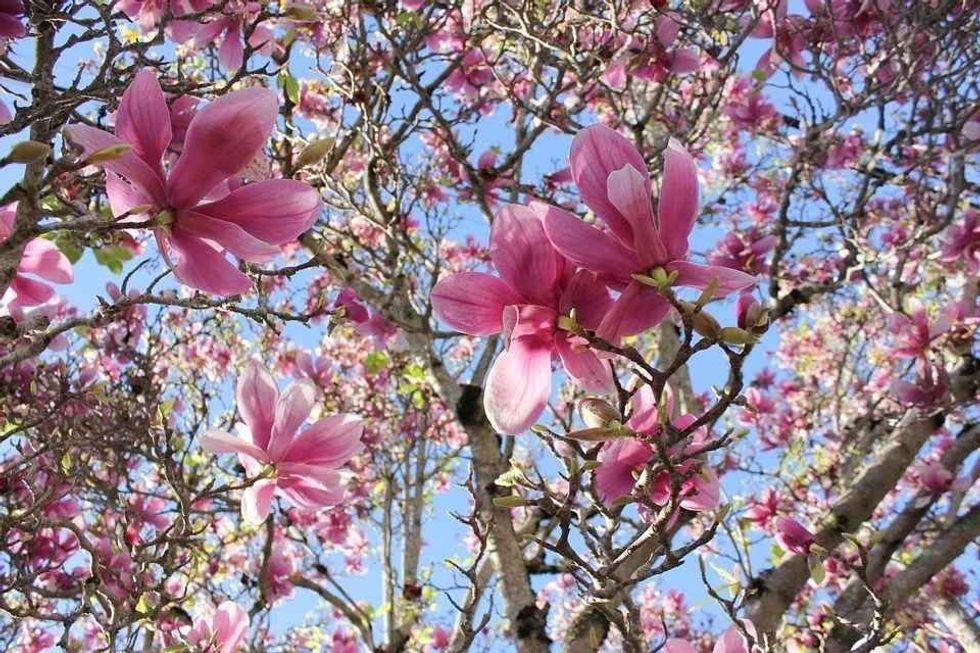Named after the French botanist, Pierre Magnol, saucer magnolia trees are a beautiful addition to any landscape.
They are known for their large, saucer-shaped flowers that can range in color from white to pink to purple. These trees are beautiful and provide many benefits.
Saucer magnolia trees are a type of magnolia tree that is known for their large, saucer-shaped flowers. The blooms of these trees can be quite impressive! One of the most unique things about saucer magnolias is their large, saucer-shaped flowers that are also highly fragrant.
Habitat Of Saucer Magnolia Trees
Saucer magnolia trees are native to the eastern United States, and they thrive in humid climates. If you live in a region with hot summers and mild winters, saucer magnolias will be right at home! However, these trees can also tolerate some colder temperatures, so they can be grown in other parts of the country as well.
Physical Features Of Saucer Magnolia Trees

The saucer magnolia family belongs to the magnolia family and their scientific name is Magnolia x soulangiana. The saucer magnolia is actually a hybrid plant between the lily magnolia and yulan magnolia.
Saucer magnolia (Magnolia x soulangiana) leaves are simple yet deciduous. In the summers, the leaves take on a dark green color, and they turn into captivating shades of yellow, orange, and red in the autumn seasons.
They sprout from their twigs with a coating of pubescent and they taper towards the base. The flower buds of this tree are fuzzy and big.
They bloom into beautiful and elegant flowers, and the flowers have both a male and female part to them. The flowers have waxy petals that are a pink-purple color on the outside and a pure white color on the inside.
The petals of the flower are arranged in the shape of a goblet or a saucer, which is why they are named saucer magnolias. They are round, upright, and erect.
The flower petals and sepals are often referred to as 'tepals' by botanists due to the difficulties in identifying the differences between the two. Their stamens and pistils are placed along the main seed-bearing cone.
The trunk and the bark are usually a gray color or an extremely light brown color. Its bark resembles a small shrub when it is in its growing stage, but soon it grows into a massive tree with a large canopy.
Caring For Saucer Magnolia Trees
Saucer magnolia (Magnolia x soulangiana) trees are relatively easy to care for. Here are a few tips to help you get started!
Saucer magnolia (Magnolia x soulangiana) trees prefer moist, well-drained soil. Be sure to water your tree regularly, especially during the summer months. Saucer magnolias grow best in full sun or partial shade.
Fertilize your saucer magnolia tree twice a year, in the spring and fall. Fertilize your saucer magnolia tree twice a year - once in the spring and once in the fall.
A balanced fertilizer is ideal. Prune your saucer magnolia tree annually, in late winter or early spring. Remove any damaged bark or branches, and prune the tree so that it is symmetrical.
Saucer magnolia trees typically bloom in the spring.
The flowers will last for several weeks, and will gradually fade away as the petals fall off.
Saucer magnolia trees can grow up to 50 ft (15.24 m) tall, so be sure to choose the right location before you plant your tree! There are many different varieties of saucer magnolia trees available on the market today too.
'Southern Charm' is a white saucer magnolia tree that blooms in the spring, the 'Royal Star' is a pink saucer magnolia tree that blooms in the spring, the 'Purple Saucer' is a purple saucer magnolia tree that blooms in the spring, the 'Teddy Bear' is a yellow saucer magnolia tree that blooms in the summer, and the 'Snowdrift' is a white saucer magnolia tree that blooms in the winter.
If you're thinking of adding a saucer magnolia to your yard, be sure to do your research first since each variety has its own unique set of requirements, growth, and care!
Growth And Pruning Of Saucer Magnolia Trees
Growing saucer magnolia trees can be a little tricky, but if done right, you will have a healthy tree with beautiful blooms.
Collect the seeds of this plant during the spring and summer. They require a period of dormancy so make sure that you plant the seeds outdoors during the fall season. The seeds should be able to germinate in spring.
Saucer magnolias are best planted in part-shade or full-sun locations. Ensure that the weather is not too extreme or too deprived since the flowers can open too early.
The strong winds of the cold early spring weather can also damage the flowers, so protect the plant from this as it grows. Saucer magnolias don't grow very well in soil that is very wet or dry. Therefore, provide the plant with rich soil that is both moist and well-draining.
To shape the plant into a tree form, pruning can be done. The broken and diseased branches can be pruned away to avoid the spread of fungal diseases.
These plants can continue to grow well without any feeding, but a spring application of fertilization can really improve its growth. During the first year of planting a saucer magnolia, water it deeply and frequently.
After this, the saucer magnolia will only need water and irrigation when the weather is dry. Once this system is established, they develop a good tolerance for drought.
FAQs
Why are magnolia trees bad?
A: Magnolia trees are not exactly bad but they can be quite difficult to care for as they can get infested with pests and diseases, which can damage the tree. Magnolia trees also require a lot of water, so they may not be suitable for homeowners who live in drought-ridden areas.
Finally, magnolia trees can grow quite large, so make sure you have enough space before you plant one!
Are saucer magnolia trees messy?
A: Saucer magnolia trees are not typically messy, but these evergreen trees may drop leaves and flowers in the fall and spring. This can be a good or bad thing, depending on your personal preference.
What will live under a magnolia tree?
A: Under a magnolia tree, there is an open invitation to creatures of all types. This may be because the broad dark green leaves provide dense shade and offer protection from the elements, or it could simply be that the sweet fragrance of the magnolia flower lures in wildlife.
Either way, if you have a magnolia tree in your yard, you're likely to see all sorts of animals taking advantage of its benefits!
Do magnolias bloom twice a year?
A: Saucer magnolia trees typically bloom in the spring. The flowers will last for several weeks, and will gradually fade away as the petals fall off.
What is the smallest magnolia?
A: Small green foliage with a compact form is the southern dwarf magnolia. Its large, shiny leaves have brownish undersides.
How long does a saucer magnolia live?
A: A saucer magnolia tree can live for 50-60 years. However, with proper care, it may live longer.
Is magnolia a bush or tree?
A: The magnolia is a tree. It can grow to be quite large, depending on the variety. Some magnolias can reach a height of 100 ft (30.48 m)!









